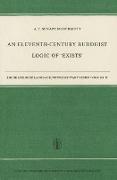- Start
- An Eleventh-Century Buddhist Logic of ¿Exists¿
An Eleventh-Century Buddhist Logic of ¿Exists¿
Angebote / Angebote:
I. RATNAKIRTI. HIS PHILOSOPHICAL CONGENERS AND ADVERSARIES Ratnakirti flourished early in the 11th century A. D. at the University of Vi kramasila, a member of the Yogacara-Vijnanavada school oflate Buddhist philosophy. Thakur characterizes Ratnakirti's writing as "more concise and logical though not so poetical" 1 as that of his guru, Jfianasrimitra, two of 2 whose dicta are focal points of the present work. From a translogical or absolute point of view , Ratnakirti endorses a form of 3 solipsistic idealism. The Sarhtdndntaradu$alJa , his proof of solipsism written from the standpoint ofthe highest truth (paramdrtha), concludes that an exter nal nonmental continuum is impossible. In ultimate reality the cognizing sub ject, its act of awareness, and the cognized object coalesce - all are fabrications superposed on what is really an indivisible evanescent now (svalak$alJa). 4 As Ratnakirti's predecessors have put it: There is neither an 'I' nor a 'he' nor a 'you' nor even an 'it', neither the thing, nor the not-thing, neither a law nor a system, neither the terms nor the relations. But there are only the cognitive events of colourless sensations which have forms but no names. They are caught for a moment in a stream and then rush to naught. Even the stream is a fiction. That sensum of the moment, the purest particular, that advaya, the indivisible unit of cognition, that is the sole reality, the rest are all fictions, stirred up by time-honoured 5 convention of language which is itself a grand fiction.
Folgt in ca. 15 Arbeitstagen


